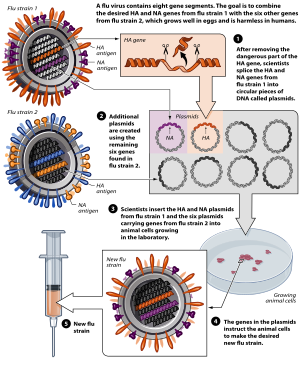
Back علم الوراثة العكسي Arabic Obratna genetika BS Reverse Genetik German Genética inversa Spanish ژنتیک معکوس FA Génétique inverse French Xenética inversa GL Genetika arah-balik ID Umsnúin erfðafræði IS Genetica inversa Italian

Reverse genetics is a method in molecular genetics that is used to help understand the function(s) of a gene by analysing the phenotypic effects caused by genetically engineering specific nucleic acid sequences within the gene. The process proceeds in the opposite direction to forward genetic screens of classical genetics. While forward genetics seeks to find the genetic basis of a phenotype or trait, reverse genetics seeks to find what phenotypes are controlled by particular genetic sequences.
Automated DNA sequencing generates large volumes of genomic sequence data relatively rapidly. Many genetic sequences are discovered in advance of other, less easily obtained, biological information. Reverse genetics attempts to connect a given genetic sequence with specific effects on the organism.[1] Reverse genetics systems can also allow the recovery and generation of infectious or defective viruses with desired mutations.[2] This allows the ability to study the virus in vitro and in vivo.
- ^ Chalfie M, Girard L (2007). WormBook the online review of C. elegans biology. Wormbook.org. OCLC 1067052025.
- ^ Kanai Y, Kobayashi T (September 2021). "FAST Proteins: Development and Use of Reverse Genetics Systems for Reoviridae Viruses". Annual Review of Virology. 8 (1): 515–536. doi:10.1146/annurev-virology-091919-070225. PMID 34586868.